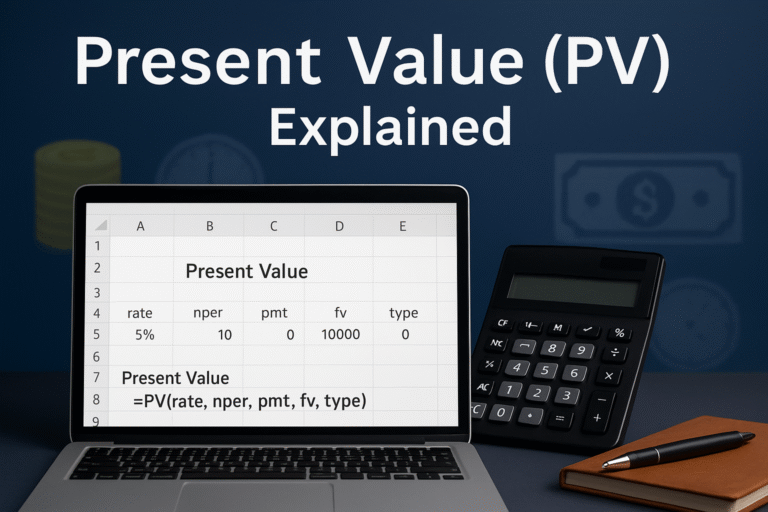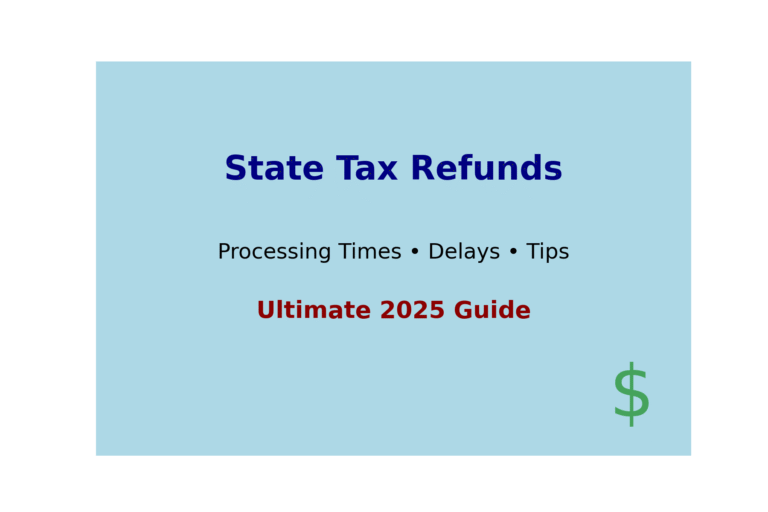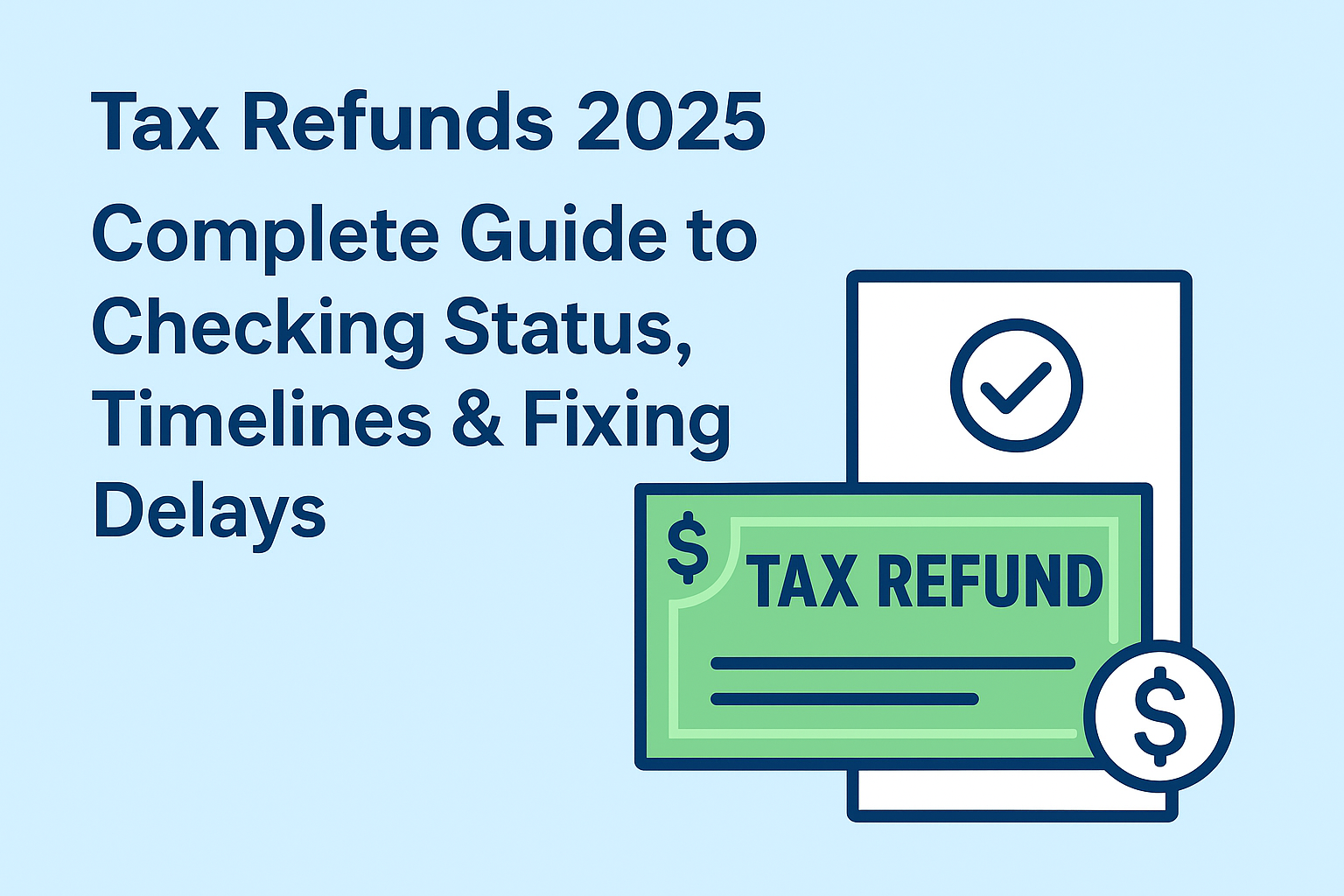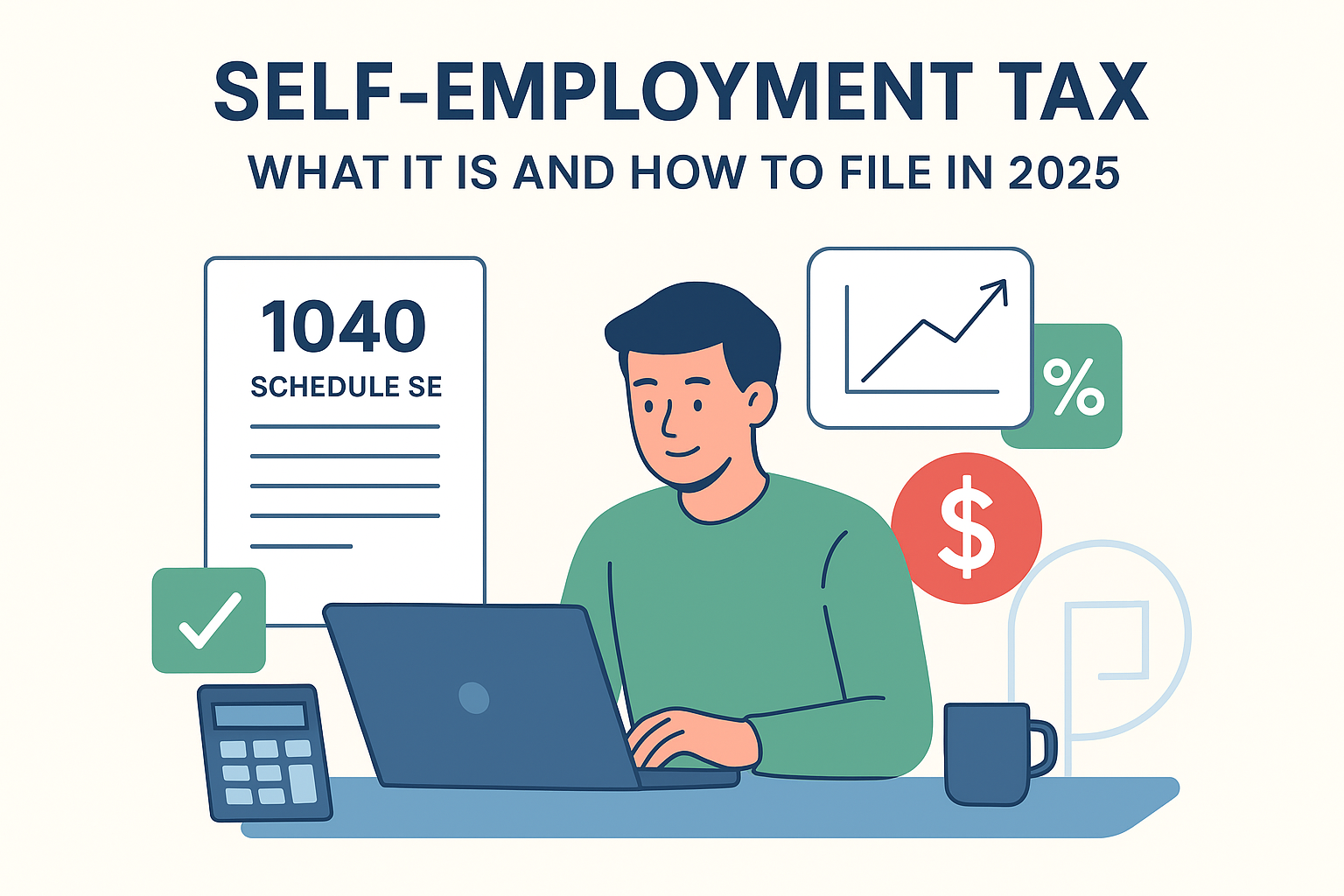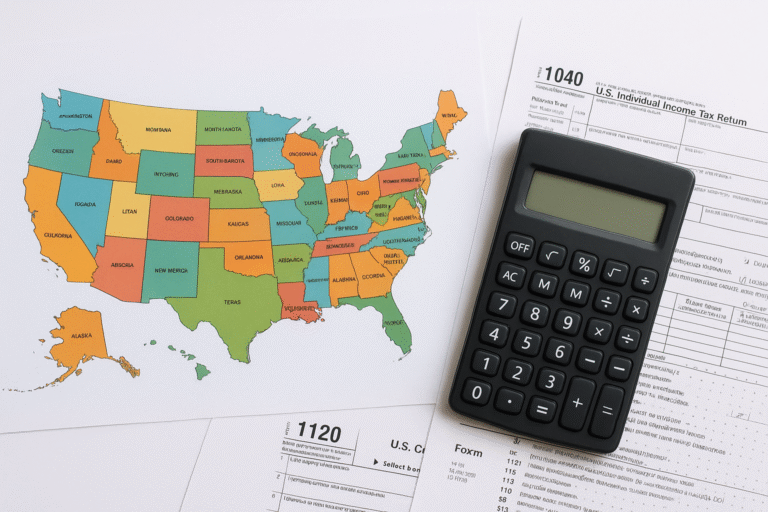Money today doesn’t stay the same tomorrow. Future value (FV) is the concept that shows how much a sum of money invested today will grow to at a certain point in the future, given an assumed interest rate or rate of return. Whether you’re saving for retirement, calculating the growth of an investment, or projecting the value of regular deposits, future value is one of the most powerful tools in finance. Investopedia
In this guide, we’ll cover the future value formula, real-world examples, Excel shortcuts, calculators, and common mistakes to avoid. So you’ll know exactly how to use FV in your own financial decisions.
TL;DR — Future Value in Plain English
Future value (FV) = the value of today’s money at a future date after compounding interest.
- Formula (lump sum): FV = PV × (1 + r)^n
- Works for lump sums, annuities, and growing payments
- Always check “real vs nominal” results (inflation eats into purchasing power)
- Use Excel’s
=FV()or online calculators for fast answers- Best for: retirement planning, savings goals, comparing investments. CalculatorSoup
What is Future Value?
At its core, future value answers a simple question: “If I invest $X today, what will it be worth in Y years?”
The most basic formula is for a lump sum investment:
FV=PV×(1 + r)^n
Where:
- PV = present value (the starting amount)
- r = interest rate per period
- n = number of periods
This captures the effect of compound growth: your money grows not only on the original investment but also on the interest it earns. Investopedia
Future Value of an Annuity (Regular Deposits)
Not everyone invests a single lump sum and then walks away. Most of us contribute regularly, such as monthly savings deposits or retirement contributions. That’s where the annuity formula comes in:
FV = {PMT}/{i}((1+i)^n – 1)
- PMT = payment per period
- i = interest rate per period
- n = total number of periods
If payments are made at the start of each period (an annuity due), multiply the result by (1 + i).
There are also growing annuities (payments that increase by a fixed % each year), useful for salary-linked retirement plans. Time value of money
Real-World Case Studies (With Numbers)
Case 1 — Lump Sum Growth
- You invest $5,000 today
- Annual rate: 6%
- Duration: 10 years
FV = 5,000×(1+0.06)^10 ≈ $8,954
Lesson: A single deposit nearly doubles in a decade with steady compounding.
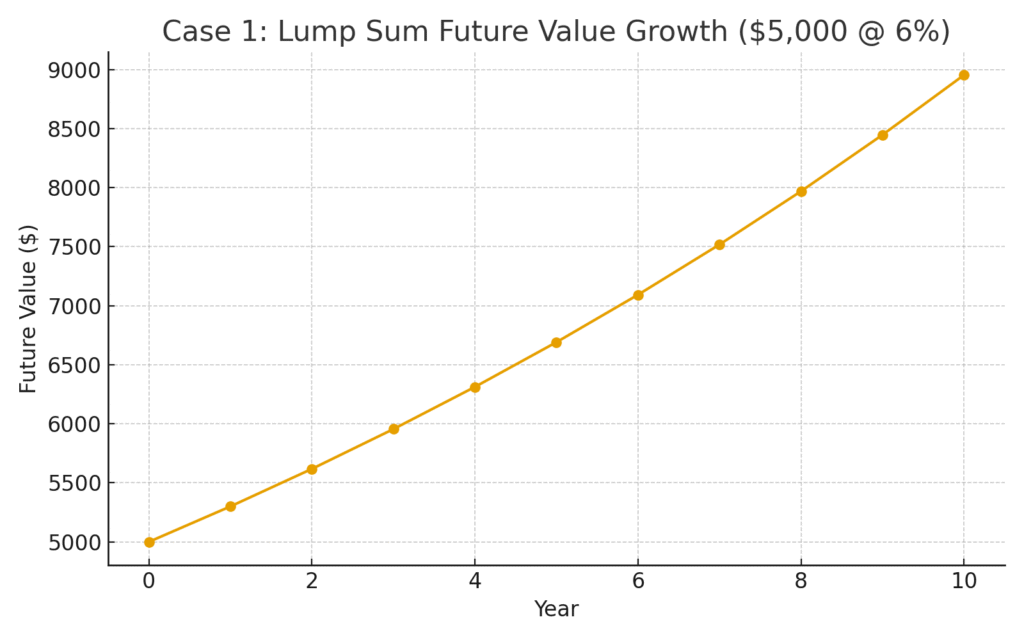
Case 2 — Monthly Contributions (Annuity)
- You save $200 per month
- Annual rate: 5% (compounded monthly)
- Duration: 20 years
FV = $200×((1+0.05/12)^240−1)/(0.05/12)
Result: ≈ $105,000
Lesson: Small, consistent contributions beat one-off deposits, compounding rewards discipline.
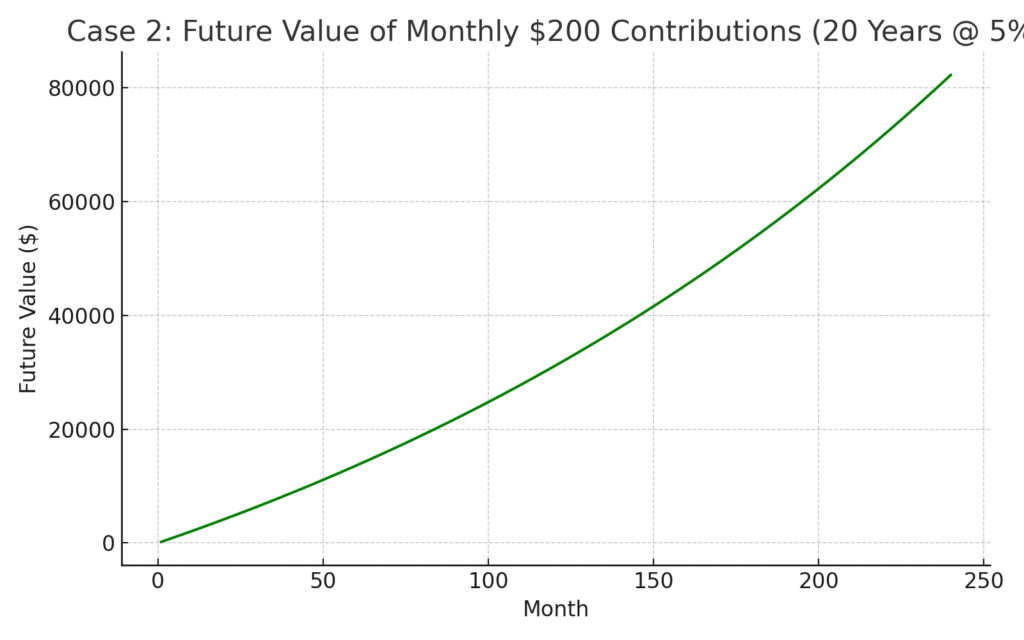
Case 3 — Inflation-Adjusted Future Value
- Starting investment: $10,000
- Nominal return: 7% annually
- Inflation: 2% annually
- Duration: 30 years
Nominal FV: $10,000×(1.07)^30 ≈ $76,122
Real FV (adjusted for inflation): ≈ $42,760
Lesson: Don’t confuse dollars with purchasing power. Always check the “real” future value.
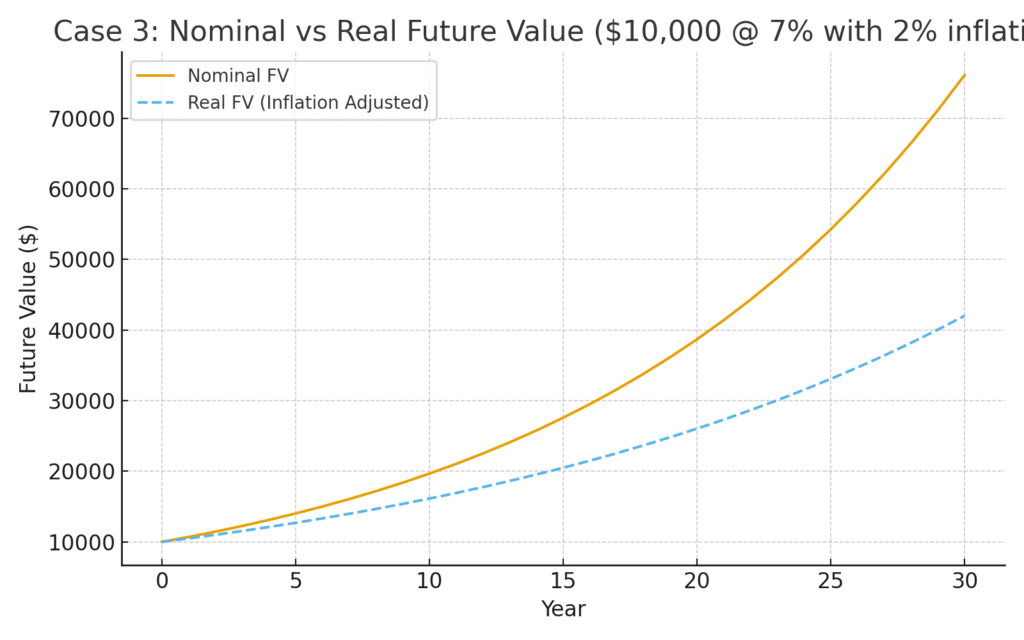
Compounding Frequency — Why It Matters
The more often interest compounds, the higher the FV.
Formula with compounding periods (m):
FV = PV×(1+r/m)^m×t
Example: $1,000 at 6% for 10 years
| Compounding | FV |
|---|---|
| Annual | $1,790.85 |
| Monthly | $1,792.00 |
| Daily | $1,792.20 |
Lesson: More compounding = more growth, but the difference shrinks once compounding is frequent.
How to Calculate FV in Excel or Google Sheets
- Manual formula:
=PV*(1+rate)^n - Built-in FV function:
=FV(rate, nper, pmt, pv, type)rate= interest per periodnper= number of periodspmt= payment per period (negative if outflow)pv= present value (negative if outflow)type= 0 (end of period), 1 (beginning)
Example: =FV(0.05/12, 240, -200, 0, 0) = $105,000 (Case 2 above).
Common Mistakes People Make with FV
- Forgetting inflation → A $1M nest egg may only buy half as much in 30 years.
- Assuming constant returns → Markets fluctuate; test conservative, base, and aggressive scenarios.
- Ignoring taxes and fees → A 7% mutual fund with 1% fees is really ~6%.
- Using the wrong compounding frequency → Always check whether your bank/plan compounds monthly, quarterly, or annually.
- Overestimating growth → Better to plan with lower rates than risk being short later.
Why Future Value Matters in Real Life
- Retirement planning: Estimate how today’s savings grow over decades.
- Education savings: Plan for college funds with regular contributions.
- Investment comparison: Compare lump sum vs annuity strategies.
- Business finance: Project future cash flows or equipment replacement funds.
Pro tip: Pair future value with present value and net present value (NPV) for full financial planning power.
Break the timeline into segments, applying each rate in order.
Use a conservative estimate based on your asset class. Stocks: 5–7% real returns historically; bonds: 2–3%.
Not unless you adjust for them. Always use an after-tax return if planning net outcomes.
Yes, but you’ll need to compound each flow separately or use Excel’s XNPV/XIRR functions.
Nominal FV = total dollars. Real FV = inflation-adjusted purchasing power.
Deduct annual fees from your return before calculating FV. Even 1% can slash long-term value dramatically.
Disclaimer
This article is for educational purposes only and should not be taken as financial advice. Investments involve risk. Please consult a licensed financial advisor before making personal financial decisions.
Author Bio
Author: Max Fonji — I’ve spent decades simplifying complex financial concepts into plain English. At TheRichGuyMath.com, I help readers understand investing, taxes, and money math without stress.


